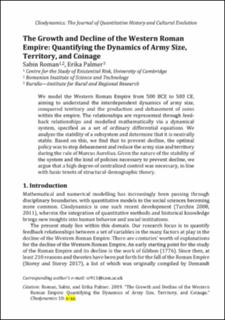The Growth and Decline of the Western Roman Empire: Quantifying the Dynamics of Army Size, Territory, and Coinage
| dc.contributor.author | Roman, Sabin | |
| dc.contributor.author | Palmer, Erika | |
| dc.date.accessioned | 2020-10-02T08:23:26Z | |
| dc.date.available | 2020-10-02T08:23:26Z | |
| dc.date.created | 2020-01-13T13:28:09Z | |
| dc.date.issued | 2019 | |
| dc.identifier.issn | 2373-7530 | |
| dc.identifier.uri | https://hdl.handle.net/11250/2680830 | |
| dc.description.abstract | We model the Western Roman Empire from 500 BCE to 500 CE, aiming to understand the interdependent dynamics of army size, conquered territory and the production and debasement of coins within the empire. The relationships are represented through feedback relationships and modelled mathematically via a dynamical system, specified as a set of ordinary differential equations. We analyze the stability of a subsystem and determine that it is neutrally stable. Based on this, we find that to prevent decline, the optimal policy was to stop debasement and reduce the army size and territory during the rule of Marcus Aurelius. Given the nature of the stability of the system and the kind of policies necessary to prevent decline, we argue that a high degree of centralized control was necessary, in line with basic tenets of structural-demographic theory. | en_US |
| dc.language.iso | eng | en_US |
| dc.title | The Growth and Decline of the Western Roman Empire: Quantifying the Dynamics of Army Size, Territory, and Coinage | en_US |
| dc.type | Journal article | en_US |
| dc.type | Peer reviewed | en_US |
| dc.source.journal | Cliodynamics | en_US |
| dc.identifier.doi | 10.21237/C7CLIO10243683 | |
| dc.identifier.cristin | 1771450 | |
| cristin.unitcode | 7501,0,0,0 | |
| cristin.unitname | RURALIS – Institutt for rural- og regionalforskning | |
| cristin.ispublished | true | |
| cristin.qualitycode | 1 |
Tilhørende fil(er)
Denne innførselen finnes i følgende samling(er)
-
Artikler [231]
Articles in scientific journals -
Publikasjoner fra CRIStin [463]
